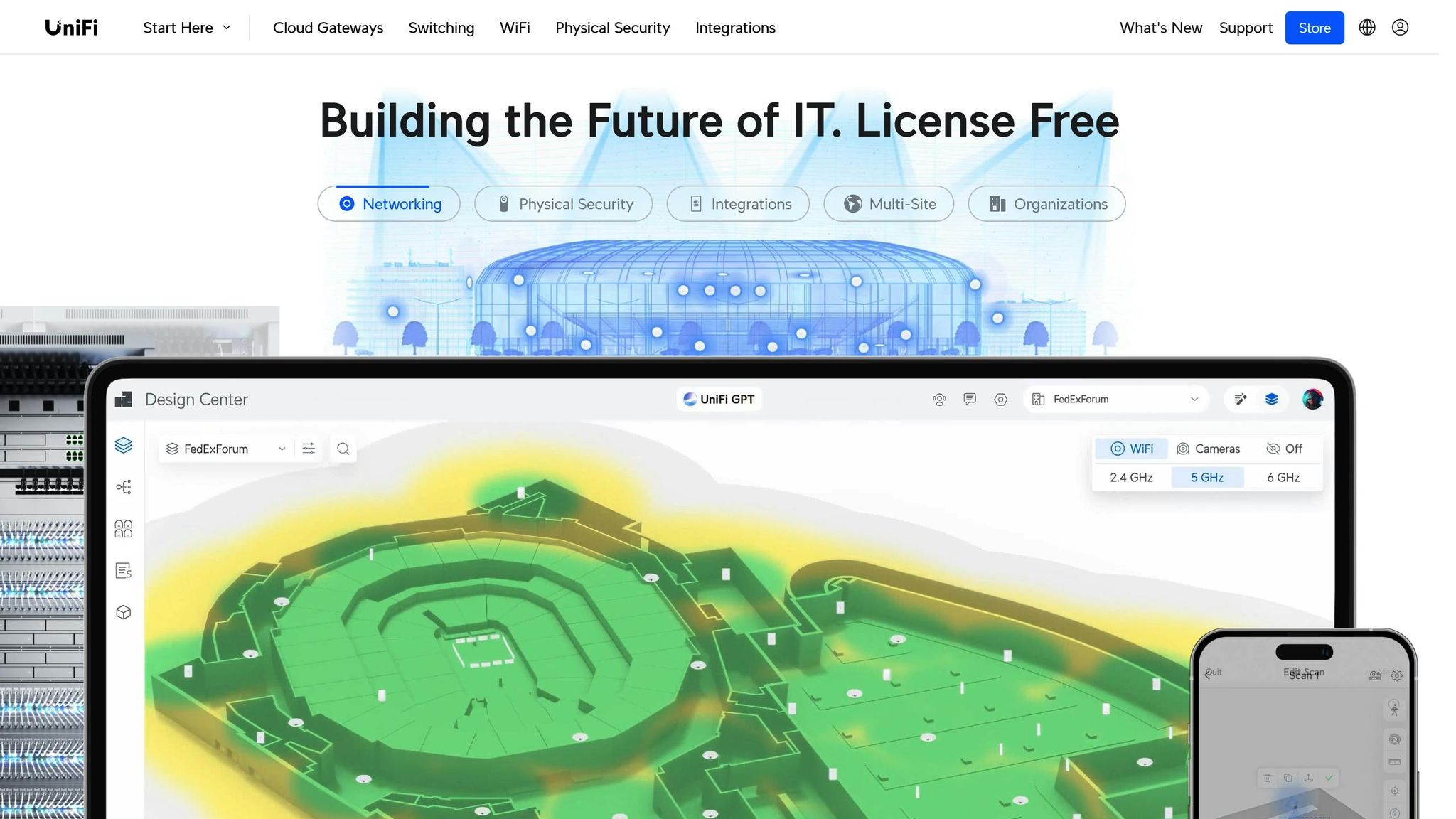Reliable bulk WiFi is the backbone of smart apartment living. It powers IoT devices like smart thermostats, leak detectors, and security cameras while ensuring seamless connectivity for residents. Without strong WiFi, these features fail, leading to frustrated tenants and higher property management costs. Here’s why it matters:
- 87% of renters demand instant internet access upon move-in.
- 67% are willing to pay more for smart devices supported by bulk WiFi.
- Properties with managed WiFi see 90% fewer support calls and can earn $30–$40 more per unit monthly.
Key Takeaways:
- Building-Wide WiFi beats unit-based setups by offering consistent connectivity across apartments and common areas.
- MDF (Main Distribution Frame) and IDFs (Independent Distribution Frames) form the infrastructure backbone, ensuring efficient and scalable networks.
- Bulk WiFi simplifies smart device integration, improves property management, and boosts resident satisfaction.
With scalable, property-wide WiFi, apartments can meet growing connectivity demands, reduce tenant turnover, and stay competitive in the rental market.
Why the UniFi Network is the Essential Backbone of My Smart Home

Core Elements of Strong Bulk WiFi Infrastructure
Creating a dependable bulk WiFi system for smart apartments involves more than just placing a few routers around the property. At its core, it’s about designing a network where all components work together seamlessly to ensure consistent, reliable connectivity for every resident and device. Let’s break down the key pieces that make this possible.
Main Distribution Frame (MDF) and Independent Distribution Frames (IDFs)
The Main Distribution Frame (MDF) is the central hub of the network. This is where the building connects to the external internet service. Inside the MDF, you’ll find critical equipment like routers, core switches, firewalls, and patch panels - these manage the flow of data between the building and the outside world [10].
On the other hand, Independent Distribution Frames (IDFs) act as smaller, localized hubs. These are placed throughout the building, typically on each floor or in key areas, to extend connectivity from the MDF to individual devices. By placing IDFs closer to where devices are located, the network minimizes the need for long cable runs, which helps maintain signal strength and reduce latency [10][11].
Here’s how they work together: the MDF connects to the internet service provider and sends high-speed data (often via fiber) to the IDFs. The IDFs then distribute that connection to access points, smart devices, and individual apartments. To keep the system efficient, cable runs between the MDF and IDFs should stay under 100 meters. Using high-quality cabling, like fiber or Cat6A, ensures a stable and reliable connection [10].
When planning your setup:
- Position the MDF near the building’s telecom entry point.
- Place IDFs within 100 meters of the devices they serve.
- Use structured cabling for both MDF and IDF configurations.
| Feature | MDF (Main Distribution Frame) | IDF (Independent Distribution Frame) |
|---|---|---|
| Location | Near telecom entry point | On each floor or key areas |
| Purpose | Connects building to external service | Connects local devices to the MDF |
| Equipment | Routers, core switches, firewalls, patch panels | Access switches, patch panels, sometimes appliances |
| Cabling | High-bandwidth uplinks to IDFs | Shorter runs to end devices |
| Security | High security; restricted and monitored | Secured, but less critical if breached |
| Scalability | Built for network-wide expansion | Scales within local zones |
| Redundancy | Often includes redundant uplinks and power | Limited local redundancy |
Centralizing the MDF simplifies troubleshooting across the entire network, while strategically placed IDFs help isolate and resolve localized issues. Together, they form the backbone of a strong WiFi infrastructure, ensuring seamless connectivity throughout the property.
Building-Wide vs. Unit-Based Connectivity
When it comes to network design, property managers often face a choice: unit-based connectivity or a building-wide network.
Unit-based connectivity relies on residents setting up their own hubs, like WiFi or Z-Wave routers, in their apartments. While this approach might seem less expensive upfront, it introduces several challenges. For example, property staff may need to enter individual units to troubleshoot or adjust settings. Additionally, if a resident removes their hub, smart devices in vacant units lose connectivity. Common areas, like lobbies or gyms, may also lack reliable internet access under this model [7].
In contrast, building-wide networks use multiple access points to provide consistent connectivity across the entire property. Though this setup requires a larger initial investment for equipment like cabling, switches, and firewalls, it becomes a long-term asset for the building. It also eliminates the need for residents to manage their own equipment [7].
Security is another major consideration. Resident-managed hubs often lack professional oversight, leaving them more vulnerable to tampering. Building-wide systems, however, are typically equipped with security gateways and intrusion monitoring tools, all managed from a centralized portal [7].
"Community WiFi offers faster speeds to residents and connectivity across sites. It's the foundation for what we want. Initiatives like EV charging stations in the parking lot – they need to be connected. We can put on a cell signal, but that might not be consistent. We want an operational network across the site, where we can connect EV chargers, access control, and camera systems that are remote from the leasing office."
- Director of Building Technology, Multifamily Owner/Operator [8]
Building-wide networks also simplify management for property teams. They ensure connectivity in common areas and vacant units without relying on residents. This unified approach supports features like IoT device integration, remote monitoring, and seamless connectivity - key components of modern smart apartments [7].
When deciding between these approaches, think about factors like the building’s capabilities, cost considerations, security needs, and long-term value. For properties prioritizing IoT integration and advanced operations, a building-wide network is often the better choice. It provides a reliable infrastructure that supports the sophisticated demands of smart apartment communities.
How Bulk WiFi Supports Smart Apartment Operations
Bulk WiFi plays a crucial role in powering smart apartments by creating a seamless network for connected devices and systems. Beyond providing reliable internet access, it enhances property management processes and improves the daily lives of residents.
IoT Device Integration and Performance
Smart apartments depend on Internet of Things (IoT) devices like smart thermostats, leak detectors, security cameras, and smart lighting to offer a connected, automated living experience. These devices require constant, reliable connectivity, which bulk WiFi ensures by delivering uninterrupted coverage throughout the property.
A survey of over 10,000 tenants found that 67% are willing to pay more for smart devices in their apartments [6]. Additionally, 87% of renters view immediate internet availability at move-in as "very important" or "absolutely essential" [1]. Bulk WiFi simplifies this process by creating a unified network for all IT and IoT applications, eliminating the need for "shadow networks" and making monitoring and maintenance more efficient [4].
In March 2025, Xfinity Communities introduced its 'Connected Building' solution, an all-in-one networking system designed for property-wide WiFi. Featuring the Multifamily Xfinity Broadband Gateway, this system supports multiple IoT devices simultaneously, making it retrofit-friendly for older buildings [13].
"Today's multifamily properties require seamless, property-wide connectivity to meet rising resident expectations and efficiently manage operations." - Ilan Eframian, Vice President of Xfinity Communities [13]
This integrated network also enhances residents' experiences by enabling remote control of smart devices. Whether locking doors, adjusting thermostats before arriving home, or receiving leak alerts, residents enjoy increased convenience and security. For property managers, this unified connectivity simplifies operational oversight and boosts efficiency.
Remote Monitoring and Property Management
For property managers, bulk WiFi offers real-time visibility and control over critical systems, streamlining maintenance and improving security response times [12]. From EV charging stations to access control systems and security cameras, reliable connectivity ensures these systems function effectively - even when located far from the leasing office.
Maintenance technicians benefit as well, staying connected with residents to manage work orders and asset tracking through mobile devices [8]. Properties with managed WiFi report fewer move-outs, faster lease-ups, and a dramatic reduction - up to 90% - in WiFi-related service calls [5]. Many bulk internet providers also offer resident support to handle internet issues directly.
Smart devices like thermostats and occupancy sensors generate valuable data that can be analyzed to identify trends, optimize energy use, and guide operational decisions [2]. Managed WiFi enables centralized operations, reducing vendor complexity and allowing properties to scale as their needs grow [5].
sbb-itb-58157f8
Improving Resident Experience with Bulk WiFi
Bulk WiFi doesn’t just streamline operations - it plays a big role in boosting resident satisfaction. A strong bulk WiFi setup transforms smart apartments into seamless digital hubs, making modern living easier while improving property management efficiency. Reliable internet isn’t just a perk; it’s a key factor in keeping residents happy and encouraging them to stay longer.
Easy Move-In and Daily Connectivity
With bulk WiFi, residents have instant internet access from the moment they move in. No waiting for installation or setup - residents can work remotely, enjoy their favorite streaming services, and connect their smart devices immediately.
This type of service also ensures faster, more reliable, and cost-effective internet access[1]. High-speed connectivity supports everything from 4K streaming to video calls and managing multiple smart home gadgets at once[3]. Plus, community-wide coverage means residents can stay connected as they move throughout the property without interruptions. In fact, nearly half of the participants in a 2022 NetGear study said uninterrupted WiFi across a property is essential for modern living[3]. On the flip side, nearly one-third of respondents called unreliable WiFi a major source of stress at home[3], highlighting the importance of dependable internet and ongoing tech support.
A 2023 survey by SmartRent and Parks Associates found that renters ranked WiFi as their third priority, tied with laundry facilities and just behind rent and safety[3]. As technology becomes an even bigger part of daily life, having scalable internet solutions is crucial to meeting these growing expectations.
Scalability and Future-Ready Networks
Bulk WiFi isn’t just about immediate convenience - it’s also about preparing for what’s next. As smart apartments evolve alongside advancing technology, scalable bulk WiFi ensures properties can support new devices and services without missing a beat. Managed WiFi solutions are built to handle future demands, helping properties stay competitive as resident needs shift and grow[9].
With more residents adding devices like voice assistants, smart appliances, and security cameras, networks need to handle increased traffic without slowing down. High-quality bulk WiFi systems maintain strong performance even as data consumption rises[15]. Regular upgrades keep the network up to speed with changing connectivity needs. Additionally, carrier-neutral setups ensure compatibility with multiple providers and offer flexible cabling options, avoiding vendor lock-in and keeping the infrastructure ready for future advancements[14].
Take, for example, the collaboration between Quext and Klika Tech to create an IoT Smart Apartment solution for The Prime Company. Their well-thought-out bulk WiFi infrastructure reduced operational headaches, cut costs, and improved experiences for both residents and staff. Early collaboration between property developers and internet service providers also proved crucial, with thoughtful low-voltage planning helping to avoid interference and costly last-minute changes.
Investing in scalable bulk WiFi gives properties a clear edge. It allows them to adopt new smart technologies quickly, meet changing resident demands, and stay appealing in an increasingly connected rental market.
Conclusion: Building Smarter Communities with Reliable Connectivity
A solid bulk WiFi infrastructure is at the heart of smart apartment living, tying together operational efficiency and enhanced resident experiences. In today’s world, reliable connectivity isn't just a perk - it’s a fundamental expectation of modern living. Meeting these expectations doesn’t just satisfy residents; it also brings measurable financial and operational benefits.
For instance, properties offering managed WiFi can generate an additional $30–$40 per unit monthly in revenue[5], while also enjoying lower turnover rates and faster lease-ups[5]. On the operational side, property managers report cutting up to 90% of WiFi-related service calls[5], allowing them to focus on more pressing priorities. Beyond these immediate benefits, investing in strong bulk WiFi infrastructure also protects the long-term value of a property. As Doug Pearce, Executive Vice President of Information Technology at Waterton, puts it:
"The trend has shifted to providing whole-building managed Wi-Fi at multifamily communities. The seamless 'curb to couch' experience for our residents, the ROI and the ability to introduce smart building functionality using the connectivity provided all are difficult reasons to ignore." [16]
Managed WiFi is quickly becoming the standard for new construction communities[16], with retrofitting older properties expanding just as rapidly[16]. This connectivity lays the groundwork for integrating IoT devices, enabling real-time monitoring, and introducing smart building technologies. It’s the digital backbone that allows properties to adapt to technological advancements, meet shifting demands, and stay ahead in a competitive market.
FAQs
What’s the difference between building-wide WiFi and individual unit-based internet in smart apartments?
Building-wide WiFi offers consistent, property-wide internet access, ensuring a dependable connection for both residents and smart devices throughout the entire apartment complex. This setup reduces dead zones, streamlines network management, and makes it easier to integrate IoT devices, delivering a more connected and hassle-free living environment.
In contrast, unit-based internet requires separate installations for each apartment. This can result in uneven coverage, signal interference, and more complex maintenance. While it might be suitable for smaller properties, it often falls short in meeting the demands of modern smart apartment systems. For a scalable and dependable solution that caters to both residents and advanced technology, building-wide WiFi stands out as the better option.
How does reliable bulk WiFi improve resident satisfaction and retention in smart apartments?
Reliable bulk WiFi is a game-changer for boosting resident satisfaction and retention in smart apartments. It delivers the high-speed internet essential for powering IoT devices, smart home systems, and everyday online activities without a hitch. This means residents can enjoy a seamless, connected lifestyle that meets modern living expectations.
A strong WiFi setup is the backbone of smart apartment features like smart thermostats, security systems, and leak detection. These tools not only make life more convenient but also enhance safety and peace of mind. When residents feel their home is both comfortable and well-connected, they’re more likely to stick around, which helps improve retention rates and generates positive buzz about the property.
What challenges might property managers encounter when installing a bulk WiFi system in older buildings?
Introducing bulk WiFi systems to older buildings can be a tricky process for property managers. Some common hurdles include interference from nearby networks, outdated or incompatible hardware, and physical barriers like thick walls or complex building layouts that can weaken signals. On top of that, older infrastructure might need major upgrades - like rewiring or replacing old systems - which can take a lot of time and money.
The process gets even more complicated when reliable service providers are hard to find, or when the building's structure limits installation options. Tackling these challenges requires thoughtful planning and a willingness to invest in the necessary upgrades to ensure residents enjoy consistent, high-speed internet access.


